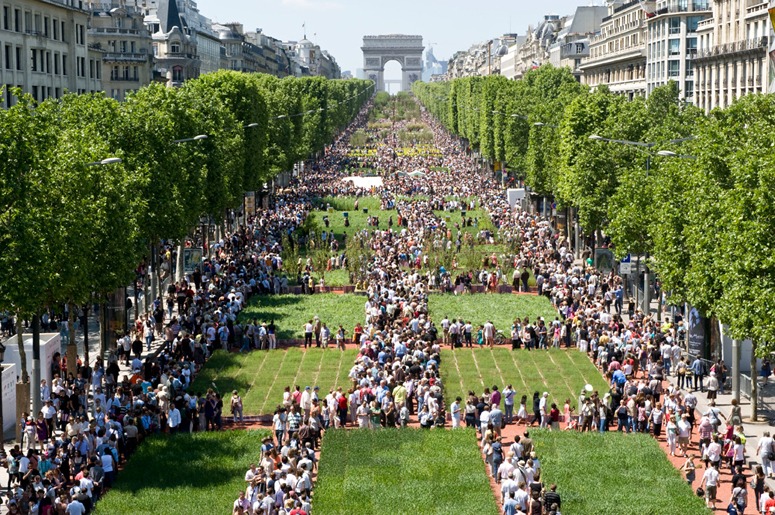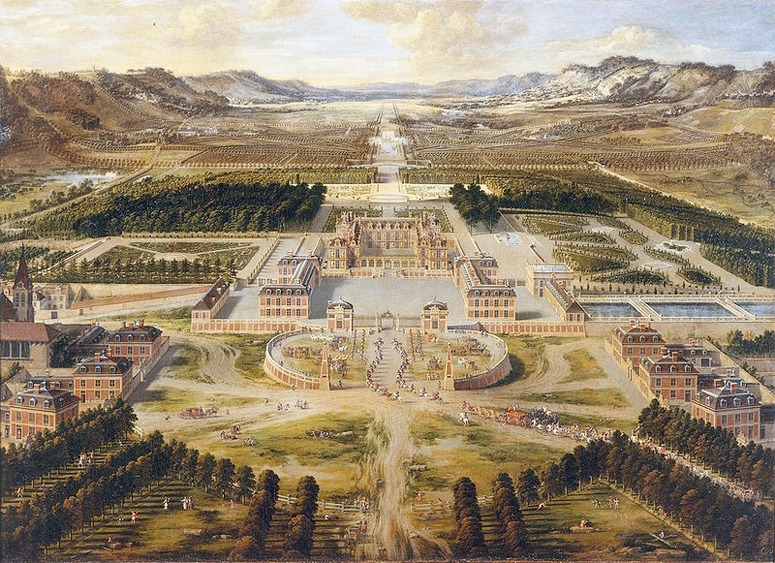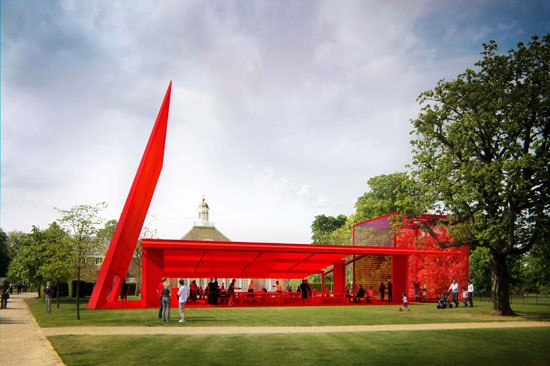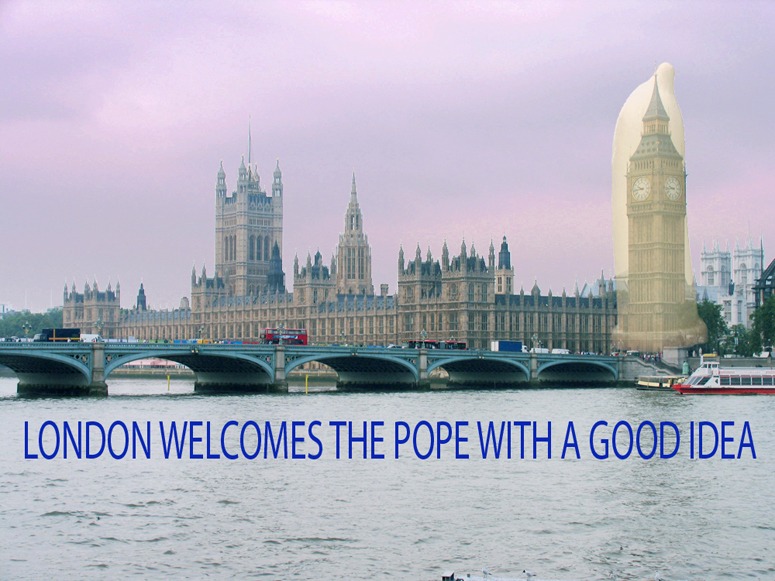Looking at London from the Eye gives a whole new perspective on the city. Another view from the Eye enables the viewer to ask ‘how green is my city?’ Some of the answers might surprise.
Paris goes green
The French farmer’s protested their financial plight in a charmingly French manner by greening the Champ-Elysee.
Another unusual example of the trend towards green is the Lost House of Paris. The occupants literally live within a greenery covered house. To travel green in the city of romance you simply phone a ‘Vectrix’ taxi.
As Pierre Patel’s 1688 painting of Versailles (below) shows, axes can be green and they can be canals. And canals can be used for transport. Civic leaders need courage, imagination, wisdom – and a wealth of ideas from the design professions.
Planning an urban landscape for London's economic and financial future
 London has had many economic roles over the centuries and now hopes to settle down as a cultural capital and somewhere between ‘Europe’s financial centre’ and ‘the world’s financial centre’. This requires a planning and design response which is likely to include
London has had many economic roles over the centuries and now hopes to settle down as a cultural capital and somewhere between ‘Europe’s financial centre’ and ‘the world’s financial centre’. This requires a planning and design response which is likely to include
(1) more large green buildings, because big firms have big space requirements
(2) more homes for young, rich and mobile people
(3) more urban public space of the highest quality and greatest variety: busy and quiet, large and small, glazed and unglazed, soft and hard, wild and cultured, space at ground level, above ground and below ground, space for shopping and space for prayer, space with quiet water, bright water, dark water, swimming water, boating water and living water, biodiversity, socially diverse space for each cultural group (listeners to Radios 1,2,3,4,5,6,7 etc) and social space for the particular interests of ethnic, work and leisure groups.
London’s new amenities could be provided on a spatterdash basis – or London could have an urban landscape plan. The Canary Wharf development on the Isle of Dogs was a key project. It points to what should be done, to how it should be done – and to where it should be done. London’s traditional rival is Paris, which has a bold plan, now over 300 years old, for projecting the axis of the Tuileries westward – to the Place de la Concorde, to the Arc de Triomphe, to La Défense and beyond. London has a modest plan for projecting Crossrail into the Thames Gateway. But London landscape planning lacks spatial imagination – and axes were a baroque idea.
London will require many new buildings. They should be of the best available quality – and they should be grouped to ‘define and contain’ new urban space of the best quality and variety. The urban space should be designed before the buildings. A great new urban landscape should be planned to run east from the Isle of Dogs. Olympia and York made a significant start when they commissioned Laurie Olin to plan Westferry Circus and the Canary Wharf central axis. Before this, the Isle of Dogs was being developed with small cheap buildings and a pitiful lack of long-term vision. The Hanna Olin plan was much better – but it was more of a plan for Visual Space than for Social Space or Ecological Space. The present period of relative economic stagnation is an opportunity to take a broad perspective on the eastward projection of London and its financial future. There should be a 3-year plan, a 30-year plan and a 300-year plan.
London should remember that ‘He that the beautiful and useful blends, Simplicity with greatness, gains all ends’. Urban designers, architects and landscape architects should plan a multi-functional urban landscape with the highest visual quality and as much sustainability as can be planned at this point in time, with conceptual principles prioritised over design deails.
Jean Nouvel Serpentine Pavilion and Garden 2010
Jean Nouvel’s design models for the Serpentine Pavilion (& see below) were attractive but ‘parked’ on the grass like a se of London buses. As built, the pavilion is better related to its context. It must be that the organizers have taken heed of the Gardenvisit blog’s comments on the 2010 Serpentine Pavilion. We remarked that ‘the Serpentine Gallery has a better opportunity to promote garden and landscape design than any other gallery in London‘. It is great that the Serpentine Gallery is moving in this direction – but I think they might have replied to my letter or left a comment on the blog to say ‘thanks a bundle’.
London's gay and liberal landscape welcomes the German Pope
Big Ben and I would like to ‘speak for England’ in respectfully reminding the German Pope that England is more important as the home of Europe’s political passion (liberalism) than as the home of the world’s most beautiful game (football). England is the country in which Hobbes and Locke wedded Latin and Germanic ideas of freedom to create the philosophy of political liberalism. Olde England & Merrie England were anti-Jewish and anti-Catholic. Modern England legislated against these attitudes. Our land now has rights to religious freedom, sexual freedom and gay rights – with the classic constraint that there can be no freedom to harm others except in self-defense. Unlike Charlemagne and Pope Benedict XVI, I respect the right of Catholic priests to engage in consensual homosexual acts, as they have always done, providing they do no violence to others with their Priapic revelry. It is deeply troubling that ‘Roman Catholic priests in the United States are dying from AIDS-related illnesses at a rate four times higher than the general population and the cause is often concealed on their death certificates‘ I therefore invite His Holiness to get a good practice idea from Big Ben. As Big Bob sang, ‘the times they are a-changin‘. The Pope should speak the truth, respect the life sciences, study the social sciences – and provide free condoms for the everlasting relief of his priestly bretheren. And even if he is queasy about women he should have due regard for their protection from AIDS and other STDs: London’s landscape demands action – now! We welcome you to London so that you can learn from London: condoms are good for the health of the clergy.

Gay pride celebration 2010 in the urban landscape of London's Trafalgar Square - the battle of Trafalgar let Europe become liberal
PS: it is not all good: the statue on the southwest plinth is of General Sir Charles James Napier (1782–1853) whose conquest of Sindh province, in what is now Pakistan, led to the famous Latin telegram pecavi (‘I have sinned’). Since Napier confessed, the Pope may want to forgive him. Napier had commanded the 50th (Queen’s Own) Regiment of Foot during Napoleon’s Campaign in the Peninsular War – so the Pope may be grateful that Germany and Italy are not part of a Napoleonic French empire?
PPS re ‘the times they are a-changin‘: click to enter the site and you can you can read the lyric and listen to different versions of the soundtrack.
PPPS Greenberg, D.F., The construction of homosexuality (1990) p.253 ‘Several of Charlemagne’s capitularies concerned sins against nature, sodomy, and homosexual relations among monks’. So Charlemagne knew what the brothers were up to – and this has not changed in the past 12 centuries.
Top quality home grown organic Charlotte potatoes, seaweed-fed, flavoured with wild mint and dressed with parsley
But a little over-cooked, sadly.







